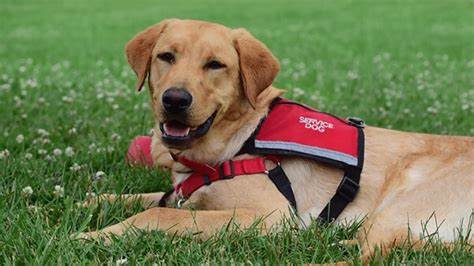- What is a Postural Tachycardia Syndrome?
- What Are the Symptoms of POTS?
- How Can POTS be Treated?
- Can a Service Animal Help A Person with POTS?
- How Can a Person With Pots Get a Service Animal?
- How Can A Service Dog Detect POTS?
- How Can a Service Dog Help Before the Onset of Dizziness/Fainting?
- How Can a Service Dog Help After the Symptoms Have Already Manifested?
- Where to Get a Service Dog

What is a Postural Tachycardia Syndrome?
Postural Tachycardia Syndrome (POTS) is considered an abnormal increase in the heart rate after sitting up or standing. This condition affects a lot of people around the world, especially girls and women from 15 to 50. Symptoms may vary in different people and while some individuals have mild symptoms, others need to handle many challenges in their daily life.
When a person suffering from PОTS stands up or sits, part of their blood has been pulled by gravity to their hands, feet, and belly area. In order to compensate for this, the blood vessels narrow, and the heart rate increases. The body tries to maintain the blood flow to the brain and the heart. This process has been conducted by the autonomic nervous system, which is responsible for the body’s automatic functions. The autonomic nervous system in persons who are dealing with POTS does not function properly and the blood flow to the heart and brain decreases when the affected person stands upright.
What Are the Symptoms of POTS?
Considering the course of this medical condition it is logical that the most common symptoms for POTS are fainting and dizziness. Other symptoms related to POTS could be:
struggling to concentrate, headaches, blurred vision, memory difficulties, chest pain, sweating, shaking, breath shortness, sleep issues.
In some cases, the cause for this condition can not be determined. It may affect people at a young age and disappear after several years or occur at an adult age due to a traumatic situation or illness.
How Can POTS be Treated?
There are different medications that can be prescribed by a medical professional as well as non-medical methods that can mitigate the symptoms of POTS like: drinking fluids (i.e. water or juice), avoiding long periods of standing, lying down, and raising your legs, raising the head at the end of the bed, so that you are not sleeping in a fully horizontal position...etc.
However, living with POTS can be really challenging, and some people need additional assistance to deal with their daily tasks.
Can a Service Animal Help A Person with POTS?
Service Dogs can provide great assistance to people dealing with POTS. Service Dogs are defined as dogs, specially trained to help people with a disability by performing tasks, directly related to this disability. In addition to the physical tasks that a service animal can be trained to perform, he/she can also provide comfort and companionship to the affected person and make them feel safe and confident.
How Can a Person With Pots Get a Service Animal?
Since service animals are trained to help people with a disability- mental or physical, an individual must be eligible to get a service animal and to be diagnosed with a “disability”. A medical professional needs to verify that the person suffers from POTS and evaluate how severe this condition is. When the symptoms are mild, the need of a service animal may not be considered reasonable.
This does not mean that persons are not allowed to train their dogs as service dogs according to their needs, as ADA (Americans with Disabilities Act) does not require service dogs to be professionally trained.
However, it is recommended individuals, who want to train their own dog as a service dog, have a letter issued by a licensed physician, as this may be required by some airlines or facilities as an additional verification for the legitimacy of the service dog.
How Can A Service Dog Detect POTS?
We can not say exactly how dogs are able to sense the change in the blood flow or in the heart rate. According to some researches dogs can recognize oncoming symptoms due to their excellent sense of smell and hearing. Some dogs, especially the ones with bigger noses (the bigger the nose, the more smell-detecting cells it contains), can recognize chemical variations when the blood pressure, the level of blood sugar or the heart rate change. In addition, due to their strong hearing skills dogs might detect their owner’s heartbeat and notify them if it is abnormal.
Although some dogs have the natural ability to detect changes in the chemical processes in the human’s body, the possibility to train dogs to perform these tasks is still considered controversial. However, according to some training organizations dogs can be trained to recognize the processes in the humans’ body, accompanying this condition.
Service Dogs can assist their owners in dealing with POTS in different ways and be able to perform a variety of tasks.
How Can a Service Dog Help Before the Onset of Dizziness/Fainting?
A service dog can bark as a warning signal so that his/her handler can take medication or take immediate preventive actions. As mentioned above there are techniques that might be helpful to mitigate the symptoms of POTS. Of course, we would recommend that you contact a medical professional for advice on how to apply them properly. Service dogs can not only alarm you about oncoming fainting but also be trained to bring you medication, beverages or to guide you to a safe place where you can lie down.
How Can a Service Dog Help After the Symptoms Have Already Manifested?
If the symptoms have already occurred and the affected person feels dizzy has a blurred vision, has lost balance, or experienced fainting, service dogs can provide great mobility/balance assistance. They can prevent their handler from falling down and protect them with their body.
If the handler experiences changes in their peripheral vision, the presence of a service animal can help them navigate in the surroundings. This way handlers can overcome dissociative episodes quicker.
Dogs can pick up and retrieve objects when handlers are unable to do it because of dizziness.
When a handler experiences episodic memory loss a service dog can use his/her episodic memory to remember where certain places or objects are like: where are the door/car keys, where their owner has parked, where is the building’s exit...etc.
If falls on the floor, the handler can lean on their dog to get up easier. Dogs can be trained to press a button on the phone to call 911 and to open the door when the medical staff arrives. Service animals can be trained to lie down next to their handler and provide comfort by just being around them as emotional support.
When having an increased heart rate or breath shortness, some people may experience panic attacks as well and the presence and comfort that service dogs provide in these situations may be crucial for the ability of the person to handle the situation quickly.
The benefits of having a service animal are both physical and emotional, but it requires a lot of commitment to have a service animal and to raise him/her properly.
Where to Get a Service Dog
We already explained in many of our articles, that service animals need regular vet visits, vaccination, exercises, practicing the learned tasks, quality time to rest and relax, since they are working animals.
You can contact a training organization that provides service animals and trust a professional to conduct proper training. The disadvantage of this option is that it may be very expensive, and some people can not afford it.
You can also contact a non-profit organization or a charity organization to acquire a service animal. In this case, you may get a service dog free of charge, or you may be required to pay a minimum application fee. However, you may need to wait a year or more for a service dog, if there are waiting lists.
You can also train your own service dog, since ADA does not require service dogs to be trained professionally. You need to keep in mind, that if you intend to travel with your service dog internationally, you may need a certificate issued by a recognized organization, since some airlines accept only certificates issued by such organizations.














